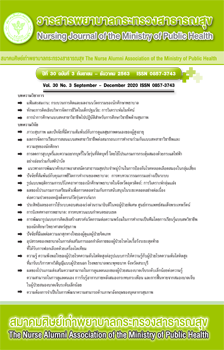Development of an Innovative Thinking Model on Readiness of Team Building Skills towards Interprofessional Education Learning of Health Science Students
Main Article Content
Abstract
This research and development study was designed to develop an innovative thinking model on readiness of team building skills towards Inter Professional Education health science students. The study was conducted in4 steps: 1) situation analysis of innovative thinking, 2) development of an innovative thinking model, 3) model implementation, and 4) effectiveness evaluation of the model. The sample consisted of fourth year health sciences students (n = 226). They were selected by purposive sampling and a willingness to participate and assessed across 4 curriculum areas: nursing, community health, public health dentistry, and Thai traditional medicine. Phase1: both quantitative and qualitative were collected using in-depth interviews. The descriptive statistics used were used frequency, percentage, mean and paired t-test. Health science students (n=40) and teachers (n = 10) were used as a focus group. The thematic content analysis was used for qualitative data. Phase 2: an innovative thinking model was developed. Phase 3: The model was implemented and assessed with 50 samples (n= 50). The instruments consisted of innovative thinking questionnaires team collaboration questionnaires and a test of knowledge, creative thinking and innovation questionnaires. The reliabilities of the questionnaires were .81, .77 and .75, respectively. The data were analyzed using frequency, percentage, paired t-test and content analysis. Phase: 4: an evaluation of the effectiveness of the model showed that the innovative thinking model consisted of concepts, objectives, interprofessional education process in creating innovation, teamwork, and authentic learning in a community. The evaluation of the effectiveness of the model showed that the mean scores of innovative thinking, teamwork readiness, and knowledge regarding innovative thinking after implementing the model were significantly higher than those of before at the level of .05.
Article Details
บทความและรายงานวิจัยในวารสารพยาบาลกระทรวงสาธารณสุข เป็นความคิดเห็นของ ผู้เขียน มิใช่ของคณะผู้จัดทำ และมิใช่ความรับผิดชอบของสมาคมศิษย์เก่าพยาบาลกระทรวงสาธารณสุข ซึ่งสามารถนำไปอ้างอิงได้
References
2. Health Administration Division. Guidelines for primary care cluster for services.[internet]. 2018. [cited 2018 November 12]. Available from : https://www.ato.moph.go.th/sites/default/files/download/primary%20care%20cluster _guide%20%28pcc%29.pdf. (In Thai).
3. Royal Thai Government Gazette. National strategic plan B.E.2561-2580. [internet]. 2019. [cited 2020 March 9]. Available form : http://www.ratchakitcha.soc.go.th/DATA/PDF/2561/A/082/T_0001.PDF. (In Thai).
4. World Health Organization. Framework for action on interprofessional education and collaborative practice. [internet]. 2010. [cited 2020 March 9]. Available form: https://www.who.int/hrh/resources/frame\work_action/en/.
5. Praboromarajchanok Institute. Praboromarajchanok institute strategic plan (2020-2024) [internet]. 2020. [cited 2020 march 9]. Available from: http://www.bcnb.ac.th/bcnb/uploads/documents/wg2/20190820_165729_121_4050.pdf. (In Thai).
6. Wongyai W, Phataphon M. Cognitive guided. [internet]. 1st ed. Bangkok: Innovative Leaders Center of Curriculum and Learning; 2019 [cited 2020 march 9]. Available from: http://www.curriculumandlearning.com/upload/Books/ชี้แนะการคิดเชิงนวัตกรรม_1572910222.pdf.
7. Sarakshetrin A, SriyasakA, Ketin V, Rongmuang D. A development of interprofessional education learning model for health promotion among the elderly in the community.Journal of Health and Nursing Research 2019;5(2):140-52. (in Thai).
8. Prathumtone V, Chenchob P, RasiriS, TheinkawS,Teerapong N. Development of an interprofessional education learning model for health promotion and disease prevention, using the community-based approach. The Southern College Network Journal of Nursing and Public Health 2020;7(2):179-93. (in Thai).
9. Sonketarin E, Sriyasak E, KetinV, Longmoung D. A development of interprofessional education learning model for health promotion among the elderly in the community. Jounal of Health and Nursing Research 2019;35(2):140-52. (in Thai).
10. Sethasathie S. A model of interprofessional education(IPE) in department of physical medicine and rehabilitation, Udonthani Hospital. Journal of Thai Rehabilitation Medicine 2015;25(2):65-70. (in Thai).
11. Zwarestein R, Barr H, Koppel A. Interprofessional education: effects on professional practice and health care outcomes.[internet]. 2000[cited 2020 March 9]. Available form: https://www.ncbi.nlam.hih.gov/pubmed/11279759.
12. Tirapaiwong Y, Aomisn K. Instructional development through professional learning communities: guideline for developing teachers and students. Journal of Boromarajonani College of Nursing, Bangkok 2018;34(2):164-72. (in Thai).
13. Tongku T. Educational Research. Mahasarakham: Apichana Publication;2007. (In Thai).
14. Reeves S, Perrier L, Goldman J, Freeth D, Zwarestein M. Interprofessional education: effects on professional practice and health care outcomes. Cochrane Database Syst Rev.2013;3. doi: 10.1002/14651858.CD0002213.pub3.PubMed MID:23543515.
15. Sethasathie S, A model of interprofessional education in department of physical medicine and rehabilitation, Udonthani Hospital. Journal of Thai Rehabilitation Medicine 2015;25(2):65-70. (In Thai).

